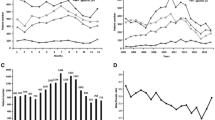Abstract
Five to ten percent of all combat injuries in the last decade of armed conflicts have been burns. Here, the incidence, demographics, and treatment are different compared to civilian practice. The percentage of hand and facial burns is higher, the population of patients is healthier, there are more associated injuries, and the transportation time is longer. Due to the prolonged transportation time, emergency treatment and also intermediate treatment are important for a good outcome in patients with burns suffered in a military environment. Treatment guidelines and education of the involved medical personnel according to the findings described herein are important for better results in future combat casualties.
Similar content being viewed by others
References
Kauvar DS, Wolf SE, Wade CE, Cancio LC, Renz EM, Holcomb JB. Burns sustained in combat explosions in Operations Iraqi and Enduring Freedom (OIF/OEF explosion burns). Burns 2006;32:853–7.
Wolf SE, Kauvar DS, Wade CE, Cancio LC, Horvath EE, White CE, Park MS, Wanek S, Albrecht MA, Blackburne LH, Barillo DJ, Holcomb JB. Comparison between civilian burns and combat burns from Operation Iraqi Freedom and Operation Enduring Freedom. Ann Surg 2006;243:786–92.
US Army Institute of Surgical Research. Joint Theater Trauma System; clinical practice guidelines 2007. San Antonio: US Army Institute of Surgical Research, 2007.
Renz EM, Cancio LC, Barillo DJ, White CE, Albrecht MC, Thompson CK, Ennis JL, Wanek SM, King JA, Chung KK, Wolf SE, Holcomb JB. Long range transport of war-related burn casualties. J Trauma 2008;64:S136–44.
Kauvar DS, Cancio LC, Wolf SE, Wade CE, Holcomb JB. Comparison of combat and non-combat burns from ongoing U.S. military operations. J Surg Res 2006;132:195–200.
Hedman TL, Renz EM, Richard RL, Quick CD, Dewey WS, Barillo DJ, Cancio LC, Baer DG, Wolf SE, Holcomb JB. Incidence and severity of combat hand burns after All Army Activity message. J Trauma 2008;64:S169–72.
Blumetti J, Hunt JL, Arnoldo BD, Brett D, Parks JK, Purdue GF. The Parkland formula under fire:is the criticism justified? J Burn Care Res 2008;29:180–6.
Brown CV, Rhee P, Chan L, Evans K, Demetriades D, Velmahos GC. Preventing renal failure in patients with rhabdomyolysis: do bicarbonate and mannitol make a difference? J Trauma 2004;56:1191–6.
Ennis JL, Chung KK, Renz EM. Joint theater trauma system implementation of burn resuscitation guidelines improves outcomes in severely burned military casualties. J Trauma 2008;64:S146–51.
Chung KK, Juncos LA, Wolf SE, et al. Continuous renal replacement therapy improves survival in severely burned military casualties with acute kidney injury. J Trauma 2008;64:S179–85.
Boffard KD. The abdomen. In: Manual of definitive surgical trauma care. London: Hodder Education, 2007:S57–61.
White CE, Renz EM. Advances in surgical care: management of severe burn injury. Crit Care Med 2008;36:S318–S324.
Author information
Authors and Affiliations
Corresponding author
Rights and permissions
About this article
Cite this article
Breederveld, R.S., Tuinebreijer, W.E. Incidence, Cause and Treatment of Burn Casualties Under War Circumstances. Eur J Trauma Emerg Surg 35, 240–243 (2009). https://doi.org/10.1007/s00068-009-9036-x
Received:
Accepted:
Published:
Issue Date:
DOI: https://doi.org/10.1007/s00068-009-9036-x




